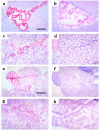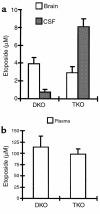Multidrug resistance protein 1 protects the choroid plexus epithelium and contributes to the blood-cerebrospinal fluid barrier - PubMed (original) (raw)
Multidrug resistance protein 1 protects the choroid plexus epithelium and contributes to the blood-cerebrospinal fluid barrier
J Wijnholds et al. J Clin Invest. 2000 Feb.
Abstract
Multidrug resistance protein 1 (MRP1) is a transporter protein that helps to protect normal cells and tumor cells against the influx of certain xenobiotics. We previously showed that Mrp1 protects against cytotoxic drugs at the testis-blood barrier, the oral epithelium, and the kidney urinary collecting duct tubules. Here, we generated Mrp1/Mdr1a/Mdr1b triple-knockout (TKO) mice, and used them together with Mdr1a/Mdr1b double-knockout (DKO) mice to study the contribution of Mrp1 to the tissue distribution and pharmacokinetics of etoposide. We observed increased toxicity in the TKO mice, which accumulated etoposide in brown adipose tissue, colon, salivary gland, heart, and the female urogenital system. Immunohistochemical staining revealed the presence of Mrp1 in the oviduct, uterus, salivary gland, and choroid plexus (CP) epithelium. To explore the transport function of Mrp1 in the CP epithelium, we used TKO and DKO mice cannulated for cerebrospinal fluid (CSF). We show here that the lack of Mrp1 protein causes etoposide levels to increase about 10-fold in the CSF after intravenous administration of the drug. Our results indicate that Mrp1 helps to limit tissue distribution of certain drugs and contributes to the blood-CSF drug-permeability barrier.
Figures
Figure 1
Loss of body weight in mice lacking Mrp1 on a genetic background lacking Mdr1a Pgp and Mdr1b Pgp (TKO mice). DKO mice, TKO mice, and Mrp1–/– mice received a single intravenous dose of 60 mg/kg Etopophos®, and the loss of body weight (%) was measured over 7 days. *P < 0.001.
Figure 2
Mrp1 staining of frozen sections of wild-type and Mrp1-deficient tissues using monoclonal antibody MRPr1. Sections were counterstained with hematoxylin. Wild-type (a, c, e, g) and Mrp1-deficient mice (b, d, f, h). (a and b) Sections of the CP showing Mrp1 staining in the CP epithelium (a). (c and d) Sections of the salivary gland. (e and f) Sections of the oviduct. (g and h) Sections of the uterus. Bar in a represents 100 μm and applies to a–d, g and h. Bar in e represents 200 μm and applies to e and f.
Figure 3
Increased accumulation of etoposide into the CSF of mice lacking Mrp1 (TKO mice) compared with mice containing Mrp1 (DKO mice). Brain vesicles were cannulated and then perfused with artificial CSF. Etopophos® (60 mg/kg) was administered via a tail vein; CSF was collected for 1 hour after drug administration, and the etoposide concentration was determined. (a) The TKO mice (n = 5) accumulated 10-fold more etoposide in the CSF than did the DKO mice (n = 4) (8.1 ± 0.9 μM and 0.8 ± 0.3 μM, respectively; P < 0.001), whereas levels in total brain (3.9 ± 0.7 μmol/kg [n = 5] and 2.9 ± 0.7 μmol/kg [n = 4], TKO and DKO mice, respectively) did not differ significantly 1 hour after drug administration. (b) Etoposide levels in plasma (98 ± 12 μM [n = 5] and 114 ± 24 μM [n = 4], TKO and DKO mice, respectively) did not differ significantly 1 hour after drug administration.
Similar articles
- Transepithelial transport of organic anions across the choroid plexus: possible involvement of organic anion transporter and multidrug resistance-associated protein.
Nishino J, Suzuki H, Sugiyama D, Kitazawa T, Ito K, Hanano M, Sugiyama Y. Nishino J, et al. J Pharmacol Exp Ther. 1999 Jul;290(1):289-94. J Pharmacol Exp Ther. 1999. PMID: 10381789 - Usefulness and limitation of primary cultured porcine choroid plexus epithelial cells as an in vitro model to study drug transport at the blood-CSF barrier.
Angelow S, Zeni P, Galla HJ. Angelow S, et al. Adv Drug Deliv Rev. 2004 Oct 14;56(12):1859-73. doi: 10.1016/j.addr.2004.07.012. Adv Drug Deliv Rev. 2004. PMID: 15381337 Review. - Choroid plexus epithelial expression of MDR1 P glycoprotein and multidrug resistance-associated protein contribute to the blood-cerebrospinal-fluid drug-permeability barrier.
Rao VV, Dahlheimer JL, Bardgett ME, Snyder AZ, Finch RA, Sartorelli AC, Piwnica-Worms D. Rao VV, et al. Proc Natl Acad Sci U S A. 1999 Mar 30;96(7):3900-5. doi: 10.1073/pnas.96.7.3900. Proc Natl Acad Sci U S A. 1999. PMID: 10097135 Free PMC article. - The pharmacological phenotype of combined multidrug-resistance mdr1a/1b- and mrp1-deficient mice.
Johnson DR, Finch RA, Lin ZP, Zeiss CJ, Sartorelli AC. Johnson DR, et al. Cancer Res. 2001 Feb 15;61(4):1469-76. Cancer Res. 2001. PMID: 11245453
Cited by
- Melatonin increases the chemosensitivity of diffuse large B-cell lymphoma cells to epirubicin by inhibiting P-glycoprotein expression via the NF-κB pathway.
Liu K, Song J, Yan Y, Zou K, Che Y, Wang B, Li Z, Yu W, Guo W, Zou L, Deng W, Sun X. Liu K, et al. Transl Oncol. 2021 Jan;14(1):100876. doi: 10.1016/j.tranon.2020.100876. Epub 2020 Sep 29. Transl Oncol. 2021. PMID: 33007707 Free PMC article. - Antiretroviral concentrations and surrogate measures of efficacy in the brain tissue and CSF of preclinical species.
Srinivas N, Rosen EP, Gilliland WM Jr, Kovarova M, Remling-Mulder L, De La Cruz G, White N, Adamson L, Schauer AP, Sykes C, Luciw P, Garcia JV, Akkina R, Kashuba ADM. Srinivas N, et al. Xenobiotica. 2019 Oct;49(10):1192-1201. doi: 10.1080/00498254.2018.1539278. Epub 2018 Dec 17. Xenobiotica. 2019. PMID: 30346892 Free PMC article. - Reduced inflammatory response in cigarette smoke exposed Mrp1/Mdr1a/1b deficient mice.
van der Deen M, Timens W, Timmer-Bosscha H, van der Strate BW, Scheper RJ, Postma DS, de Vries EG, Kerstjens HA. van der Deen M, et al. Respir Res. 2007 Jul 7;8(1):49. doi: 10.1186/1465-9921-8-49. Respir Res. 2007. PMID: 17617921 Free PMC article. - Choroid plexus transport: gene deletion studies.
Keep RF, Smith DE. Keep RF, et al. Fluids Barriers CNS. 2011 Nov 4;8(1):26. doi: 10.1186/2045-8118-8-26. Fluids Barriers CNS. 2011. PMID: 22053861 Free PMC article. - Localization of ZIP14 and ZIP8 in HIBCPP Cells.
Morgan SE, Schroten H, Ishikawa H, Zhao N. Morgan SE, et al. Brain Sci. 2020 Aug 8;10(8):534. doi: 10.3390/brainsci10080534. Brain Sci. 2020. PMID: 32784388 Free PMC article.
References
- Gottesman MM, Hrycyna CA, Schoenlein PV, Germann UA, Pastan I. Genetic analysis of the multidrug transporter. Annu Rev Genet. 1995;29:607–649. - PubMed
- Allikmets R, Schriml LM, Hutchinson A, Romano-Spica V, Dean M. A human placenta-specific ATP-binding cassette gene (ABCP) on chromosome 4q22 that is involved in multidrug resistance. Cancer Res. 1998;58:5337–5339. - PubMed
- Miyake K, et al. Molecular cloning of cDNAs which are highly overexpressed in mitoxantrone-resistant cells: demonstration of homology to ABC transport genes. Cancer Res. 1999;59:8–13. - PubMed
- Keppler D, Leier I, Jedlitschky G, König J. ATP-dependent transport of glutathione S-conjugates by the multidrug resistance protein MRP1 and its apical isoform MRP2. Chem Biol Interact. 1998;111–112:153–161. - PubMed
Publication types
MeSH terms
Substances
LinkOut - more resources
Full Text Sources
Other Literature Sources
Molecular Biology Databases
Research Materials
Miscellaneous


